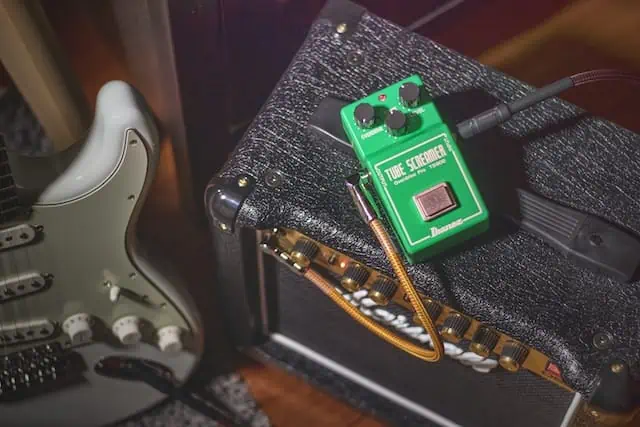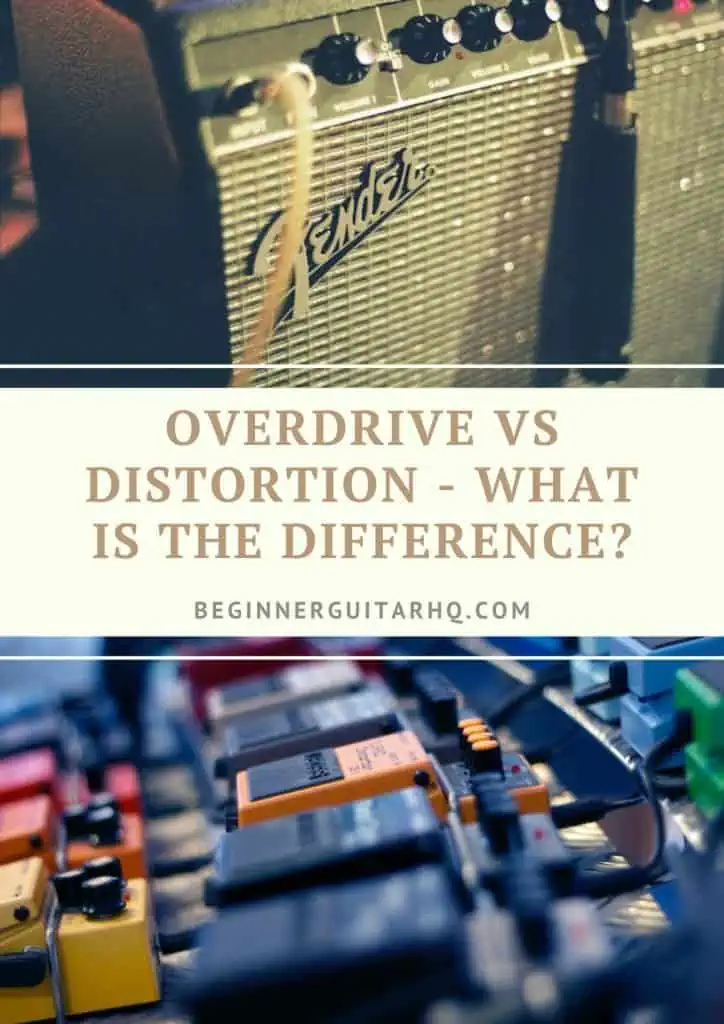The terms overdrive and distortion are often used interchangeably. Afterall, they both create a gritty, dirty tone as opposed to a clean guitar sound. But overdrive and distortion are two different things. The way they came about are also different. How you use them, in terms of genres and feel, will differ.
Overdrive vs distortion. Which is best, and how are they different? We’ll be exploring that, plus, you’ll be getting a pedal buying guide for those of you who prefer to be able to turn these effects on and off without ever letting go of your guitar. Also, in the case of natural overdrive, your ears and that of your neighbors will thank you.
What is Overdrive?
Overdrive is the soft clipping of an audio signal. If you’ve ever looked at a DAW (digital audio workstation), you’ll have come across nice round, flowing music waves. These waves are called sine waves. They’re a bit like S’s on their sides that connect in a long continuous string. Clipping, which you’ll be familiar with if your levels weren’t right, will cause things to turn red (literally in some DAWs), and you will hear that what’s coming through the system no longer sounds good. In fact, it’s dangerous for your speakers and even your computer.
However, going through an amp, overdrive sounds awesome and you really have to overdo it to cause damage. You’ll see the once round waves become a little flatter at the top as the signal clips. Natural overdrive is produced when you crank a tube (aka valve) amp past what the tubes can handle while still emitting clean sound. This is part of the reason why you need to replace the tubes around every two years, maybe even sooner if you play it hard a lot. Eventually, the tubes burn out.
To do produce overdrive, you turn up the gain and volume until you get the amount of overdrive you want. Tube amps generally don’t sound as good at low volumes anyway. But it does mean that naturally, without the aid of a pedal, your neighbors will hear what you’re playing, and certainly anyone you live with. If you jam for long periods of time, that also isn’t so good for your ears.
Many guitarists still believe that tube amps are where it’s at. Overdrive on a tube amp is warm and full of character. Still, solid state amps these days do a decent job too. You can get the same effect using an overdrive pedal, and it really does sound best on a tube amp. The pedal allows you to push the tubes in your valve amp, or the transistors in your solid state amp harder so that you get overdrive. In the case of the tube amp, it does this without you needing to crank the volume up too loud.
Why Overdrive Is Great
Aside from sounding awesome (I tend to prefer using overdrive and generally don’t like clean electric guitar unless things are getting funky). Overdrive is easier to control. It tends to add grit to your sound without muddying the tone, so chords sound great, and picking your strings sound equally great.
The Top 5 Overdrive Pedals for Your Budget
While it’s true that price is often an indication of quality when it comes to musical equipment, there are gems out there at all price points. You don’t need to break the bank to own a decent overdrive pedal. And if you can afford it, why not get a top of the line item. No matter where you’re at in terms of cash, there’s something for you here. For a full buying guide, check this article out.
Moskyaudio Mini Obsessive Overdrive Effect Pedal- Budget Pedal
If you’re looking for an affordable but durable overdrive pedal with all the standard settings to get just the right sound, here you go. You get dials to adjust the gain, tone, and volume. There’s also a high peak and low peak switch so that you can fatten up the overdrive or tone it right down. Plus, you can increase the headroom by using an 18v adapter instead of the standard 9v adapter. Most people feel like it sounds as good and even better than pedals triple the price or more.
Ibanez Tube Screamer Mini- For Fans of Ibanez
For a little bit more, you’ll get the Tube Screamer Mini, a smaller version of the full size Tube Screamer. This little pedal is simple. With the standard tone, level, and overdrive control knobs, you can tweak your sound to get it where you want it. The stomp button is sensitive, so no more stomping with no effect. Most people enjoy this pedal and feel it works well for both solos and rhythm.
Boss BD-2 Blues Driver Guitar Effects Pedal- For Blues Guitarists
If the blues are your thing, you might like the BD-2 Blues Driver pedal. It provides a warm crunch for that classic blues guitar sound. That said, it’s pretty versatile and can be used for other genres too. You can set the level, tone, and gain to your liking, for either overdrive or distortion. The pedal is responsive, so you can switch it on or off without any worries. Boss backs this pedal with a 5-year warranty, so you can spend that extra cash with confidence. Most people love this way this pedal sounds with a variety of guitars and amps.
BOSS WAZA Craft Super Overdrive Guitar Pedal- For Those Who Like Variety
At around $50 more than the previous Boss pedal, you get the WAZA Craft Super Overdrive pedal. There are two modes, standard and custom. With standard, you get that SD-1 sound that Boss is known for. With custom mode offers a new range of tone and gain to get creative with your overdrive. Over and above that, use the level, tone and gain controls to get the tone you want. Most people love the full, warm tone of this overdrive pedal, providing just the right amount of crunch.
Wampler Paisley Drive Deluxe Overdrive Pedal- For Complete Tone Control
While you may need to fork out more for this pedal than the others on this list, the Brad Paisley signature overdrive pedal gives you so much control over your sound. This combines the Underdog pedal and Paisley pedal into one. You have two channels that can be played individually or stacked. Channel 1 allows for complete EQ control as well as level and gain control. Channel 2 gives you tone, level, and gain controls. Create your own tone, or sound just like Brad Paisley. Most people use words like incredible and amazing to describe this pedal.
What Is Distortion?
Distortion is hard clipping of an audio signal. If you see this represented as sound waves, you’ll see the waves are almost square. It’s a harsher, grittier sound. And when done right, you can hear harmonies. Many hard rock and metal guitars favor distortion over overdrive because it sounds darker and heavier. But you get different types of distortion. It’s not just for hard rock and metal.
You can play around with the distortion level on your amp if you have that setting. Most modern amps, both solid state and tube amps, will include this setting along with overdrive. You’ll also get distortion by cranking the volume up even more on a tube amp. Also to note, distortion isn’t caused by volume when using a pedal, so no matter how loudly or softly you play, you’ll still get distortion. This is true of solid-state amps too.
Where distortion can go wrong is if you crank it too high to the point where it totally muddies the sound. What you end up with is chords that tend to sound like an indistinct, snarling mess. Sometimes, it’s like white noise is playing on top of the actual notes. Most of the time, guitarists don’t push it quite that far. But if you want a very dirty, muddy sound, go right ahead. It’s been done before in the name of metal and creativity. After all, music tends to be subjective anyway.
When it comes to pedals, it’s more about ease of control. I recommend that if you’re into pedals, get an overdrive pedal too. Because they work by boosting signal, if you put the overdrive pedal head of the distortion, you get an automatic boost.
Why Is Distortion Great?
You can get pretty creative, well, as much as you can when adjusting the amount or type of distortion. You can get different pedals for different genres, this makes it easier if you like a specific amount and type of distortion. And even then you can tweak it.
The Top 5 Distortion Pedals For Your Budget
As with overdrive pedals, there are a range of distortion pedals that will suit your budget. And cheap doesn’t always mean crap. Here are some of the best at each price point. For specifics, check out these distortion pedals for metal and bass guitars. Otherwise, here are my picks for the best pedals in price ranges from low to high.
Caline CP-15 Tantrum Guitar Metal Distortion Pedal- Budget Pedal
The Tantrum gives you quite a bit of control over your sound, which is pretty awesome at this price point. You get a 3-band EQ, as well as controls for distortion, volume, and boost. What’s handy is that there is also a stomp button for the boost, so you can use it or not as needed. For metal, this distortion pedal does a great job. It’s recommended to play around with the sound till you get one you like, as they all affect each other. This is the case anyway with most pedals. Most people love this pedal and are impressed at the value for money.
Pro Co RAT2 Distortion Pedal- For Affordable Industry-Trusted Gear
For a bit more, the RAT2 gives you warm distortion that sounds a lot like a tube amp. Not just that, but there are more than a few famous guitarists who have used the RAT range, so there is quality and dependability. Tweak your tone using the distortion, filter, and volume control knobs. The biggest complaint about this pedal is that the rubber feet make it difficult to mount on a pedal board. It does better with tube amps, but you will still get decent tone with a solid-state amp.
BOSS WAZA Craft HM-2W Heavy Metal Guitar Effects Pedal- For Fans of Chainsaw Distortion
For those who love the original HM-2W chainsaw distortion, Boss provided that in the WAZA Craft HM-2W, but with lower noise. Keep it on standard mode for that. Want more aggression and variety to play with? Select custom mode. Get the tone you want with the level, color, and distortion controls. Basically, what you get is a lot of the old sound, but with a lot more, all produced with better technology. Most people are more than satisfied with this pedal, enjoying the variety and relishing the heavy distortion it’s capable of.
Wampler Sovereign V2 Distortion Guitar Effects Pedal- For Versatility
Despite its size, the Sovereign V2 provides quite a bit of versatility. Whether you want a vintage or modern tone, heavy distortion or a little overdrive, this pedal delivers. It has gain, volume, mid-contour, and tone knobs. It also has a gain/boost switch, and a modern/vintage switch. There is a bypass relay with a soft switch too.
The thing you need to be careful with is clipping (the kind that’s bad for your computer and speakers). The gain is quite high with this pedal. You also need to tweak your sound as it can sound a little too digital, although that’s just fine if that’s what you like.
Wampler Pinnacle Deluxe V2 Distortion Guitar Effects Pedal- For Full Tone Control
If you want a pedal that you can tweak just so, the Pinnacle Deluxe is a solid choice. You get a 3-band EQ, a gain control knob, and a volume knob. You also get a modern/vintage switch, a boost/gain switch, as well as bypass and boost stomp buttons. What so many guitarists love about this pedal is that you get authentic brown noise distortion. They also love the overall punchy sound and the versatility of the EQ.
What About Fuzz?
I feel fuzz is worth a mention, although I doubt anyone confused fuzz with either of the above-mentioned effects if you listen to them side by side. Generally, you’ll need to get a fuzz pedal, though you may find some modelling amps that have a fuzz effect. If you thought hectic distortion was cray-cray, fuzz pedals clip the signal so hard that you can’t really play anything other than lead or riffs. Well, you can, but it creates a unique sound often described as weird. But when done well, it can sound awesome!
There is a lot more white noise involved, which gives the guitar coming through the amp a fuzzy sound. If you look at the sound waves, you’d see proper square waves. Check out these fuzz pedals if this is more what you want.
Conclusion
To summarize, overdrive is that bit of crunch that we’ve all heard on so many tracks. It’s great for rhythm and solos. Distortion is harsher and darker, but you get different types of distortion that open up its use to genres other than just metal and rock. For those of you who like variety, playing around with the gain and EQ on these pedals can get you overdrive or distortion. Many amps have these settings too.
And anyone with a tube amp who’s really cranked the volume and gain can attest to the warm overdrive and distortion that those amps naturally provide. That said, do your ears a favor, and get a pedal or two. Your neighbors will thank you too.
Happy jamming!

Cheanné Lombard lives in the home of one of the new Seven World Wonders, Cape Town, South Africa. She can’t go a day without listening to or making music.
Her love of music started when her grandparents gave her a guitar. It was a smaller version of the full-sized guitars fit for her little hands. Later came a keyboard and a few years after that, a beautiful dreadnought guitar and a violin too. While she is self-taught when it comes to the guitar, she had piano lessons as a child and is now taking violin lessons as an adult.
She has been playing guitar for over 15 years and enjoys a good jam session with her husband, also an avid guitarist. In fact, the way he played those jazzy, bluesy numbers that kindled the fire in her punk rock heart. Now she explores a variety of genres and plays in the church worship group too and with whoever else is up for a jam session.


